Thunderbolt: Difference between revisions
(→System 7000: Added catalog page) |
m (Information on the possible 2000 configurations is still unclear and needs more research.) |
||
| Line 45: | Line 45: | ||
=== Thunderbolt 2000 === | === Thunderbolt 2000 === | ||
The '''Thunderbolt 2000''' is a variant from the 1950s with a gas-powered blower. | The '''Thunderbolt 2000''' is a variant from the 1950s with a gas-powered blower. It is unclear wether this model was offered in dual tone or not. It is also noteworthy that later on, some 2000s had the gas engines removed and replaced with electric motors. This was prominent during the 1970s, logically as a result of the various gas crises in that decade. The blower was powered by a two cylinder, two stroke Wisconsin (likely air cooled) engine. The blower size can be implied to be a 6MC size, as the 2000s were built solely in the 1950s, with the 5M only coming out in the very early 1960s, thus making the possibility of 5M 2000s either anachronistic, or a parts swap job if any exist. Some cities ended up with some, notably the outskirts of Los Angeles, and Phoenix Arizona. Units also existed in Florida and Detroit, MI. Only one 2000 stands today in Los Angeles, CA. Some 2000s are in private possession in Phoenix, Arizona as well. | ||
[[File:SanDimasT-bolt12.jpg|thumb|The gasoline engine for a Thunderbolt 2000. This unit no longer exists.]] | [[File:SanDimasT-bolt12.jpg|thumb|The gasoline engine for a Thunderbolt 2000. This unit no longer exists.]] | ||
| Line 52: | Line 52: | ||
The '''System 7000''', a variant of the original Thunderbolt versions, is equipped with a self-contained generator. This particular series came in three versions; the 7012, corresponding to the 1000. the 7022, corresponding to the 1000T, and the 7026, corresponding to the 1003. [[File:Thunderbolt 7026 Kuwait.jpg|thumbnail|A System 7026 sounding off in the City of Kuwait during the Gulf War in 1991.]] | The '''System 7000''', a variant of the original Thunderbolt versions, is equipped with a self-contained generator. This particular series came in three versions; the 7012, corresponding to the 1000. the 7022, corresponding to the 1000T, and the 7026, corresponding to the 1003. [[File:Thunderbolt 7026 Kuwait.jpg|thumbnail|A System 7026 sounding off in the City of Kuwait during the Gulf War in 1991.]] | ||
==Other Information== | ==Other Information== | ||
Revision as of 23:26, 29 January 2018
| Thunderbolt | |
[[File: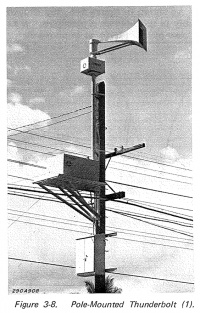
| |
| Company | Federal Signal Corporation |
|---|---|
| Produced | 1952-1993 |
| Type | Electromechanical |
| Sound output | 125-130 |
| Voltage | 120, 220, 240, or 480 V |
| Succeeded by | 2001SRN |
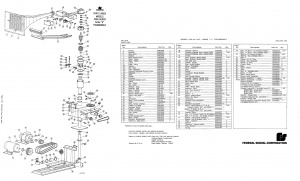
The Thunderbolt siren was a supercharged electromechanical siren produced by Federal Enterprises, which later became known as Federal Sign & Signal, and finally Federal Signal. The Thunderbolt has seven chopper levels, or voltage settings, that allow the pitch to be adjusted on the chopper, which gave the benefit to use lower or higher tones depending on the terrain and surroundings. The Thunderbolt can come in three port ratios, 5 Port single tone, or 4/5, and 5/6 Port dual tone. This siren was invented in the late 40s/early 50s as a cold war siren to warn the public of an air raid attack, later to be reissued as a multi-purpose disaster siren for weather, chemical spills, fires, or anything else that may deem appropriate. This siren went through many changes throughout it's life, and made quite a reputation as one of the best sirens in the market.
Pre-Production
As with any siren, prototypes for the Thunderbolt did exist. These prototypes included such units as ones with rounded horns, rounded blower and rotator covers, even non-rotational ones. The rounded rotator and blower unit is the unit that appears on very early Federal advertisements. One unit turned up in photos from a siren study in Jefferson City, Missouri. Another unit was supposedly destroyed in the Trinity nuclear test in the early 50s. A person claimed to have found the remains of a rounded thunderbolt rotator panel on a former test site, however no evidence ever surfaced to back this. It could be implied that the poster lied or was mistaken on his find. One other prototype unit turned up in photos that appears to have an oblonged rotator. This unit was tested in Minneapolis, MN in early 1952. To this day, it is presumed that none of the prototype Thunderbolts survived into the 21st century.
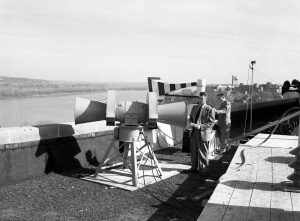
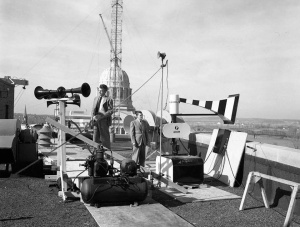
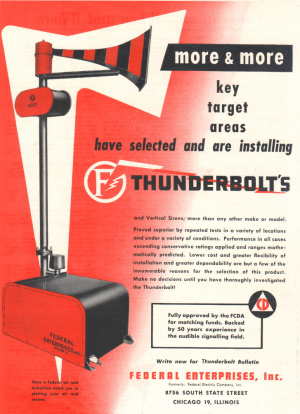
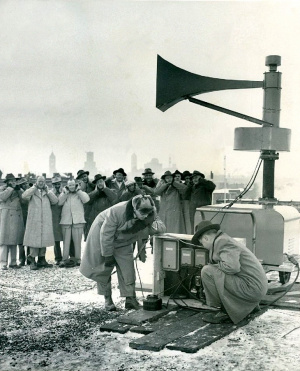
Thunderbolt 1000
The Thunderbolt 1000 is a single-tone siren. The 1000's chopper has 5 ports. This model was the first and last of the Thunderbolt, being the only model from 1952-1955, optional from 1960-1992, then the one and only model in 1993.
Thunderbolt 1000T
The Thunderbolt 1000T is a dual-toned siren. The 1000T came in 4/5 or 5/6 port ratios, which correspond to minor 3rd and major 3rd intervals, respectively.
Thunderbolt 1003
The Thunderbolt 1003 uses two solenoids that are attached to the throat of the horn. Each solenoid has a gate that closes off one row of ports on the stator. They are used to create alternating steady, alternating wail, pulsed steady, and pulsed wail signals, which can be used as a fire warning. Otherwise, it is identical to the 1000T, but used the 5/6 rotor only. Although the 4/5 port rotor is compatible, it was never offered originally. The 1003 entered production around 1959, and ceased in 1990.
Some units were adapted for other purposes as well. For instance, two units were adapted for train horns, by means of removing the rotator, and adding a custom flat projector as opposed to the regular Thunderbolt horn. It is unknown if these units had blowers or not. This setup was two Union Pacific Centennial engines; numbers 6918 and 6924 specifically. The setups were installed in roughly Mid-1979, and were gone by 1984. None of the two exist to this day. Both engines are still in service as of 2017.
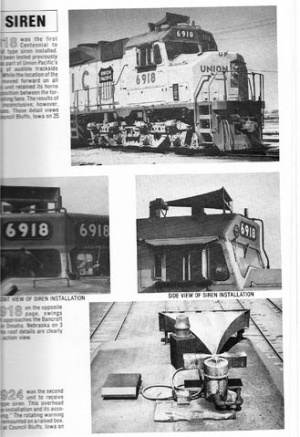
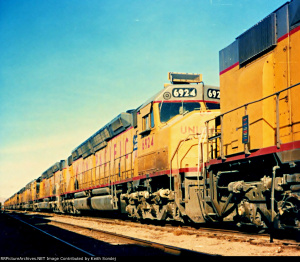
Other models
Thunderbolt 2000
The Thunderbolt 2000 is a variant from the 1950s with a gas-powered blower. It is unclear wether this model was offered in dual tone or not. It is also noteworthy that later on, some 2000s had the gas engines removed and replaced with electric motors. This was prominent during the 1970s, logically as a result of the various gas crises in that decade. The blower was powered by a two cylinder, two stroke Wisconsin (likely air cooled) engine. The blower size can be implied to be a 6MC size, as the 2000s were built solely in the 1950s, with the 5M only coming out in the very early 1960s, thus making the possibility of 5M 2000s either anachronistic, or a parts swap job if any exist. Some cities ended up with some, notably the outskirts of Los Angeles, and Phoenix Arizona. Units also existed in Florida and Detroit, MI. Only one 2000 stands today in Los Angeles, CA. Some 2000s are in private possession in Phoenix, Arizona as well.
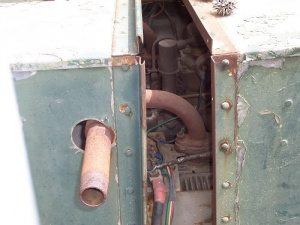
System 7000
The System 7000, a variant of the original Thunderbolt versions, is equipped with a self-contained generator. This particular series came in three versions; the 7012, corresponding to the 1000. the 7022, corresponding to the 1000T, and the 7026, corresponding to the 1003.
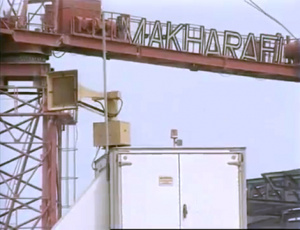
Other Information
Rotators
Originally the Thunderbolt used a motor and an Abart gear reducer driven by pulley to drive the large spur gear which makes the projector rotate. The pulleys utilized 3 different belt slots to change the RPM in which the siren rotates, from 2, 4, and 8 RPM. In the 80s Federal wanted to make the Thunderbolt more maintenance free, doing so by turning the motor and gear reducer to face each other and attached to make a direct drive system which rotated at 4 RPM. This rotator was used only on the B-series models. Later at the end of the Thunderbolt's life, Federal tried one more time to make the Thunderbolt better by designing an even better rotation system that would surpass the B-series model. The idea was to make it compact, and efficient. Think of it as a B-series, but in the shape of a cube, with a more reliable and low maintenance gear reducer, also keeping the collector rings in the chopper tube and not inside the rotator. This rotator was only featured on the last Thunderbolt model in 1993, and made it's appearance again on the 2001-SRNB, now used on the latest 2001-130, Equinox, and 508 sirens from Federal.
Blowers
All Thunderbolts run on what is known as a "blower" to push air to the top of the siren to increase sound output. The type of blower has changed during production; starting in 1952, thunderbolts used a 6M, then switched to the 5M blower around 1960, later to the 4M in the late 1960s. This was used up until 1980, when thunderbolts started to have the 4M roots blower mounted vertically, which was used all the way up to the end of its production in 1993. The units consisted of a motor and a Sutorbilt roots blower unit that was driven by belt pulleys attached to the blower and motor. The blower then took in air and pushed it into the pipes. They also had a "relief valve" that was mounted right outside of the roots blower, this acted as a "jam protection" system that would open if something was stuck in the standpipe. If something was stuck inside, air pressure would build up and would lift the relief valve open and let the air escape before the blower either, perforated the standpipe, blew off the chopper in the siren, or possibly cause the blower to literally explode.
Projectors
A notable feature of some Thunderbolts is their projector, or "horn". The earliest thunderbolts had metal cross support bars, now referred to as "Jailbars", throughout the horn making a 3x3 grid in the front, 2x2 in the middle, and 2x2 in the back. This acted like reinforcements. Since the Thunderbolt was new at the time, Federal wanted to make sure the horn did not warp or bend as this would ruin the sound output. After 1952, Federal started testing to see if there really was any benefit from having these "supports" in the projector, this caused some models to have them, and some to lack them. After 1955, it became obvious that the thick metal panels used for the projector were strong enough to not compromise the projector itself. Federal decided to drop the reinforced projectors and continue making the models with nothing more than a mesh screen used to keep various animals, insects, and debris out so the rotor wouldn't lock up leading to a burnt motor.